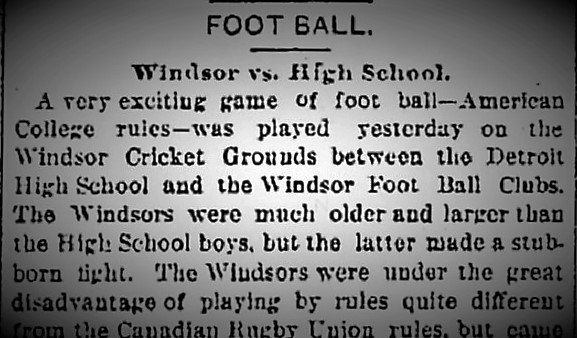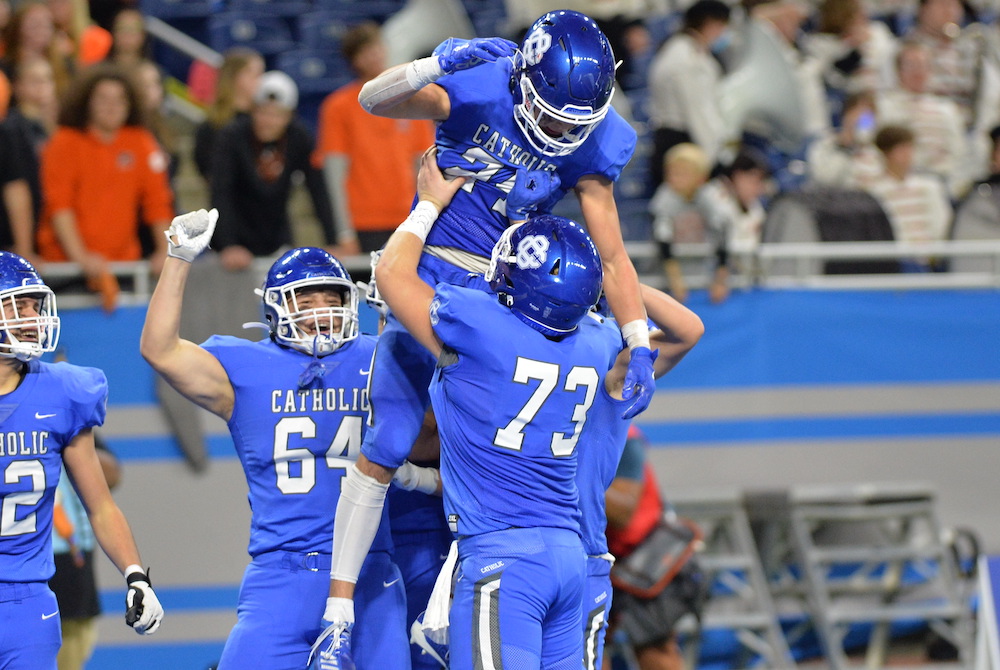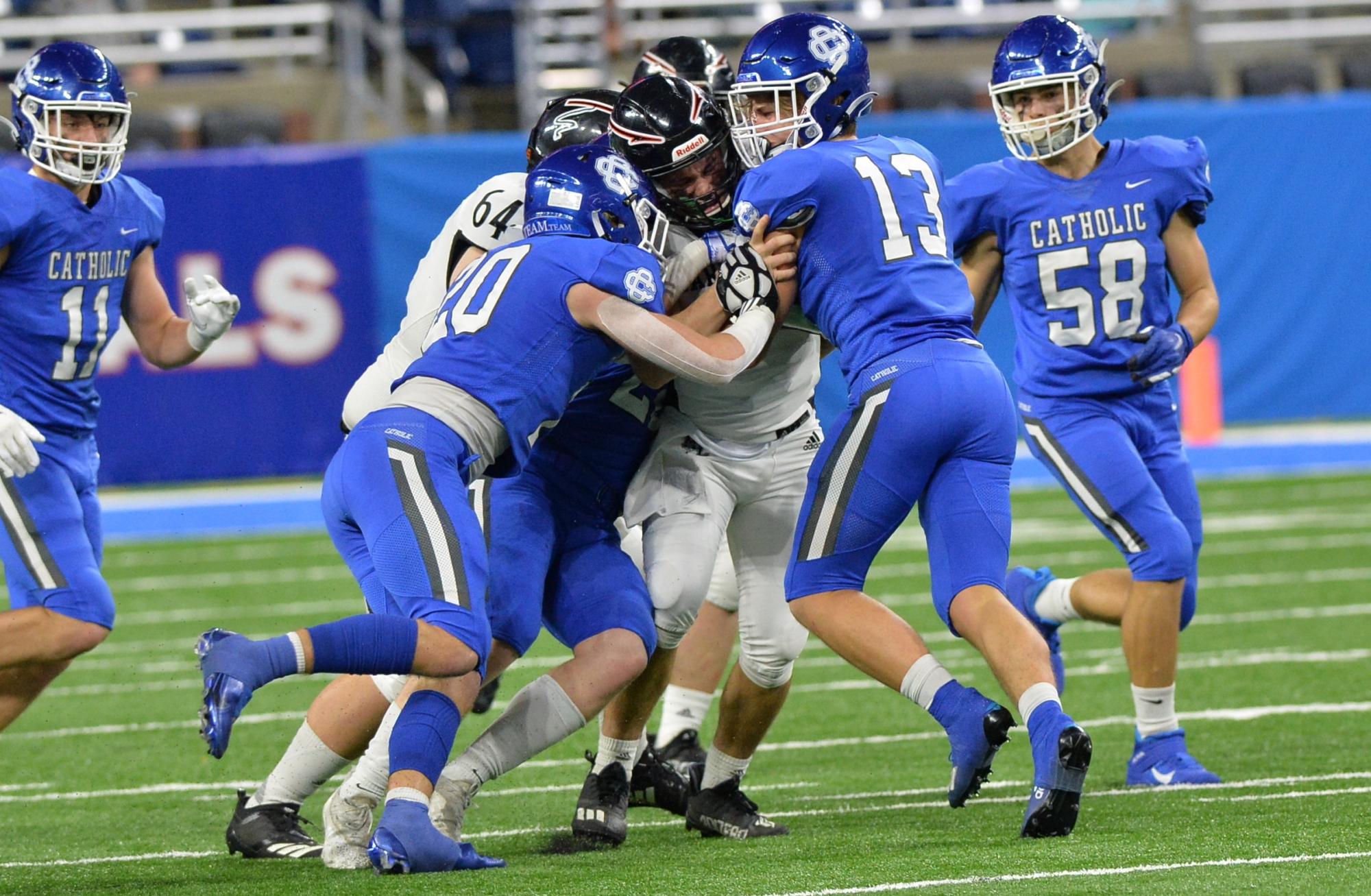
Football Kicks Off Again, 129 Years Later
August 25, 2017
By Ron Pesch
Special for Second Half
Buried in the text on the fourth page of the Saturday, October 27, 1888, Detroit Free Press is a single, concise sentence bearing a minimum amount of detail.
“The Windsor foot ball team will play the Detroit High School team this afternoon at 3.”
To date, this is the earliest account of a Michigan high school playing the game of “foot ball.”
The following day’s paper provides only a few more details. The game was played on the Windsor Cricket Grounds. Despite the great disadvantage of playing under “American Football rules … quite different from the Canadian Rugby Union rules …” the “older and larger” Windsors won the contest, 12-6. Rosters for each squad were provided.
 Under American rules of the time, a touchdown was worth four points, with a conversion kick following a touchdown worth two additional points. At the time, a field goal counted for five points and a safety was worth two. The teams, however, may have agreed to a different scoring system before the contest.
Under American rules of the time, a touchdown was worth four points, with a conversion kick following a touchdown worth two additional points. At the time, a field goal counted for five points and a safety was worth two. The teams, however, may have agreed to a different scoring system before the contest.
Was this the first football game for a Michigan high school? That’s unlikely, but it is certainly among the earliest published accounts involving a prep game in the state.
It’s a fair assumption that foot ball, or some version of the game, was being played in neighborhoods before that time, at least based on the following statement found in the Jackson Citizen Patriot, dated June 18, 1867. Only days before, Dorrance & Goodwin’s, a store on Main Street in Jackson, had placed advertisements in the newspaper’s classifieds noting the pending arrival of this new product.
“Foot Ball – The pastime was inaugurated on our streets yesterday. Three or four balls were kept in motion all day on Main street alone. It affords no little amusement to the little boys, and is certainly a healthy exercise for the larger ones. It’s all right as long as no windows are broken or horses scared. Both calamities were barely escaped scores of times during the day.”
Rutgers and Princeton are credited with playing the first college football game in 1869. A decade later, in 1879, the University of Michigan established a football team.
Detroit High School played a number of games in 1888, besides the Windsor match, including a contest with the Tappen School from the Corktown area of Detroit. Played at the Detroit Athletic Club grounds on the afternoon of Thursday November 15, a final score was not mentioned in the following day’s Free Press.
For those unfamiliar with the sport, an account of the University of Michigan versus Detroit Athletic Club contest that appeared in the November 18 Free Press served as a fine introduction to the game, and the determination behind securing “possession of a leather-covered foot ball.”
“It was very interesting to see one speedy young man, after a desperate struggle in which the spectators fully expected to see him lose an arm or a leg, get away from his captors and start like a deer, with eight or ten of the opposite side in full pursuit. He is overtaken and the leader of the pursuing party springs upon the back of the man with the inflated trophy, bearing him to the ground with a dull thud … It is also an inspiring sight to see a fleet-footed player seize the ball and run at full speed in the direction of the goal of his opponents. Then a wing-footed opponent cuts across to intercept him, makes a flying leap, grasps the fugitive around the neck or waist and both go to grass with a suddenness and velocity that transforms them into human wheels …
 “While one unaccustomed to foot ball will naturally be startled by some of the acrobatic feats, still it is impossible to watch the game for any length of time without a tingling of the blood and holding of the breath. It is most intensely exciting, continuous in action and replete with fine points of play.
“While one unaccustomed to foot ball will naturally be startled by some of the acrobatic feats, still it is impossible to watch the game for any length of time without a tingling of the blood and holding of the breath. It is most intensely exciting, continuous in action and replete with fine points of play.
“It may be explained that the goals in a foot ball game are set at a distance of 330 feet from each other. The goal is made by placing two pieces of scantling twenty feet long upright in the ground, eighteen and one-half feet apart. Another piece runs midway horizontally between the uprights, and the ball must go over the horizontal piece and between the uprights to count a goal. There are eleven men on each side and the object is, of course, to get the ball through the goal of the other. The time of game is an hour and a half each side playing forty-five minutes from each goal, with an intermission of ten minutes between halves.”
A player who ran over an opponent’s goal line, “with the ball and touched it down” was then entitled to “bring the ball in front of the goal and attempt to kick it through”…
Among those playing for the Athletic Club squad that day was “little Hugh Brooks (captain) of the high school team.” Eligibility rules for players would evolve over time.
On Saturday, November 24, Detroit High School squared off for the first of two contests with Ann Arbor High School, this one at the Detroit Athletic Club grounds. Admission to the 2:45 p.m. contests was 25 cents. A crowd of around 300 watched “an exciting illustration of how Rugby foot ball is played. The exhibition by the Ann Arbor boys was considerably better than that of the Detroiters,” noted the Free Press, “the result of that being that Detroit’s banners have been kicked into the dust.”
Ann Arbor returned home with a 12-0 victory.
A second game with Ann Arbor was quickly scheduled.
In between, on Thursday, November 29, the Detroit High School squad played the Athletic Club before a crowd of about 200.
 “While the Athletics won by 12 to 0, still their playing was very loose, probably the result of over confidence. The Athletics will have to rid themselves of this by Saturday or the Albions will make short work of them.”
“While the Athletics won by 12 to 0, still their playing was very loose, probably the result of over confidence. The Athletics will have to rid themselves of this by Saturday or the Albions will make short work of them.”
A large crowd gathered in the drizzling rain in Ann Arbor on Saturday, December 8, for what appears to be the final contest of the 1888 season for the high school teams of Detroit and Ann Arbor.
“It was a fine game. (Captain) Brooks, McGraw and Wisner, for Detroit, and Jewett, Diggert, Dupont, and Rathbone for Ann Arbor, made fine plays for their respective sides.” The result was an 8 to 2 win, and redemption, for the Detroit squad.
Today, 129 years later, “football” has seen wild expansion, numerous rule changes, and huge advancement in equipment worn when compared to those pioneer days of the sport. In 2017, more than 1 million individuals will suit up for high school teams across the United States. In Michigan alone, more than 36,000 participate in prep football.
And our state’s original programs live on. On Friday, Detroit Central opened its season with a win over Detroit Loyola. Ann Arbor High School, renamed Ann Arbor Pioneer in the late 1960s, fell in its Friday opener to Muskegon.
Welcome to another season of America’s favorite pastime.
 Ron Pesch has taken an active role in researching the history of MHSAA events since 1985 and began writing for MHSAA Finals programs in 1986, adding additional features and "flashbacks" in 1992. He inherited the title of MHSAA historian from the late Dick Kishpaugh following the 1993-94 school year, and resides in Muskegon. Contact him at [email protected] with ideas for historical articles.
Ron Pesch has taken an active role in researching the history of MHSAA events since 1985 and began writing for MHSAA Finals programs in 1986, adding additional features and "flashbacks" in 1992. He inherited the title of MHSAA historian from the late Dick Kishpaugh following the 1993-94 school year, and resides in Muskegon. Contact him at [email protected] with ideas for historical articles.
PHOTOS: (Top) The Detroit Free Press included brief coverage of the first "reported" game on Oct. 28, 1888. (Middle) When Michigan’s state government moved from Detroit to Lansing in 1847, the old Capitol building was re-opened as the Detroit’s first city high school in 1863. To better accommodate Detroit’s growing population, the old two-story structure was remodeled into a four-story building, unrecognizable to most. The school served the city well until January 1893, when it burned to the ground. (Below) Erected in 1856 at the cost of $27,000, Ann Arbor High School at State and Huron (now site of the North Quad of the University of Michigan) was destroyed by fire in 1904. (Photos courtesy of Ron Pesch.)

Receiver-Turned-QB Finishes Job Helping GRCC Run Title Streak to 3
By
Scott DeCamp
Special for MHSAA.com
November 27, 2021
DETROIT – To the casual observer, Grand Rapids Catholic Central’s fifth MHSAA football title in six years may seem a little ho-hum.
Don’t tell that to John Passinault. This one was special – way different than what he may have envisioned at the start of the season.
The senior quarterback connected with Notre Dame commit Nolan Ziegler on a pair of second-half touchdown passes, and the GRCC defense did the rest in a 31-7 victory over Marine City in the Division 5 Final on Saturday at Ford Field.
Joey Silveri, GRCC’s three-year starting QB, suffered a season-ending knee injury in Week 4. That’s when Passinault, a 6-foot, 180-pound converted receiver, switched to the signal-caller position. Passinault picked up where Silveri left off and helped lead the Cougars to a second-straight Division 5 title, their sixth championship in the last dozen years and seventh overall.
“Well, it’s surreal. Before the season, if you would have told me this was going to happen, I would have told you you’re crazy,” said Passinault, who finished the game 15-of-28 passing for 221 yards with one interception.
“A bad thing happened to a really good kid, Joey Silveri, and that’s just the mindset of the team to step in where it’s needed. I went from wide receiver to quarterback and it’s pretty easy to do that when I have guys around me like Nolan, Ronin Russell-Dixon, Devin Fridley-Bell, Luke Kuzner, Jack Rellinger. I have all those guys around me, it’s easy to step into that role and just settle in.”
GRCC (14-0) completed its third perfect season in the last five years, but Marine City (13-1) made the Cougars work for it for the better part of three quarters Saturday.
GRCC led 10-0 in the second quarter after a 29-yard field goal by junior John Meyer and a 2-yard TD run by Rellinger, a senior. Marine City hung in there, however, and pulled within 10-7 on junior QB Jeff Heaslip’s 3-yard scoring pass to senior Charles Tigert with a little more than three minutes left in the half.
The score remained that way until the closing seconds of the third quarter. Ziegler, a 6-4, 210-pound receiver and linebacker, caught a pass over the middle from Passinault, turned the corner and raced down the sideline for a 59-yard scoring play.
That seemed to ignite the Cougars’ offense a bit.
 “My team, they blocked well, it was a great pass by John,” Ziegler said. “We were just kind of playing backyard football out there honestly, and we just got things going. I got a good block from the receivers, and I just got down and got it in.”
“My team, they blocked well, it was a great pass by John,” Ziegler said. “We were just kind of playing backyard football out there honestly, and we just got things going. I got a good block from the receivers, and I just got down and got it in.”
The Passinault-to-Ziegler connection struck again four minutes later, this time on a 17-yard TD play, as the Cougars began to pull away. Ziegler finished with seven receptions for 136 yards, plus he notched a game-high 13 tackles in displaying his Power Five college football credentials.
Senior linebacker Jack Klafeta put the exclamation point on the victory for GRCC with a 34-yard scoop-and-score midway through the fourth quarter. Klafeta notched nine tackles, as did junior Jack Cook.
“Just their athleticism all over the field, their physicality up front, made things very difficult,” said Marine City coach Daryn Letson, whose team allowed no more than 14 points in a single game this season prior to Saturday.
“You know, our defense played their hearts out. I think our whole team played their hearts out,” Letson said. “You know, they have those kids and we just weren’t able to do enough offensively when we needed to.”
GRCC finished with a narrow edge in total offense, 228-215. The Mariners outrushed the Cougars, 77-7.
Heaslip was 14-of-22 passing for 138 yards. Senior Wyatt Walker led Marine City defensively with nine tackles.
This was the sixth state title in 10 seasons overall for GRCC coach Todd Kolster, who is now 112-12 at the Cougars’ helm. They also won titles under him in 2010, 2016, 2017, 2019 and 2020. GRCC’s first came in 1987.
Kolster said the Cougars made great strides from the start of this season.
“It’s a pretty surreal thing for these guys up here – just unbelievably proud of them for so much that they’ve accomplished this year,” he said. “This team probably has come as far as any football team in a season that I’ve coached.
“Just coming together, learning what it takes, getting experience, understanding each other, fighting, competing. That’s a process and we were far, far away with them at the beginning of the season. To come here and be able to get this done, the credit goes 100 percent to our seniors.”
It was an emotional farewell for Passinault. He carried on the strong QB play provided by Silveri, who is a college prospect and led the Cougars to Finals titles in 2019 and 2020.
As a passer, Passinault proved more than capable in his own right. He threw for 2,307 yards and 37 TDs this season.
“This is it. That will probably be the last time I ever play football, so it’s just crazy to think that that’s the last time I’ll play specifically with these people,” Passinault said. “ … It’s just crazy. As a kid, you just dream about this. And to have it happen, it’s just a surreal feeling – and having dreams come true, it’s crazy.”
PHOTOS (Top) Grand Rapids Catholic Central’s Will Smith (73) hoists teammate Nolan Ziegler as they celebrate during Friday’s Division 5 championship win. (Middle) A host of GRCC and Marine City players stack up to a standstill. (Photos by Hockey Weekly Action Photos.)

